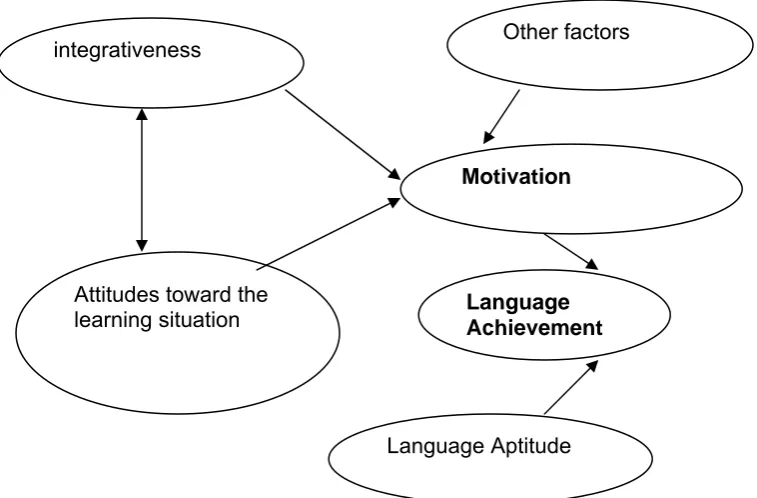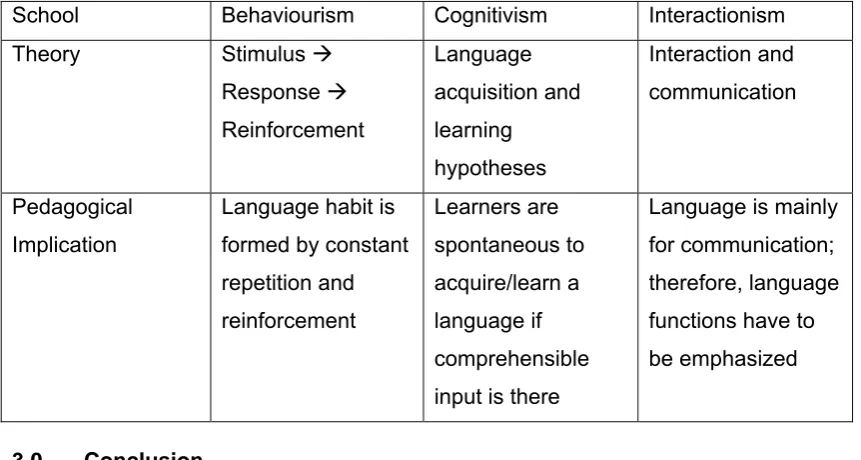A STUDY ON SECOND LANGUAGE LEARNING AND MOTIVATION
Yvonne Choong Foong Hiam1, Dr. Azizah Rajab2, Dr. Hadina Habi2
1. Faculty of Education,Universiti Teknologi Malaysia1
2. Department of Modern Languages, Faculty of Management and Human Resource Development. Universiti Teknologi Malaysia2
Abstract
This concept paper has presented some theories related to second language learning and motivation. A basic integrative motivation model in second language learning proposed by Gardner and Lambert (1982) has been introduced. Besides, pedagogical implications of Behaviourism, Cognitivism and Interactionism in second language learning are discussed. Based on the theories, a proper research will be done to find out the reasons and hindrances of learning a second language; and the motivational level in a language classroom will be studied as well (as shown in research questions).
1.0 Introduction
The growing importance of English in Malaysia has been shown through the changes in its education policy since English plays a vital role in realising Vision 2020, set by Tun Dr. Mahathir Mohamad, the former Prime Minister of Malaysia, to help transform our country into an Information Technology (IT)-based scientific society where English is necessary for assimilating IT in developing our country.
Due to the emphasis of the language usage itself, our government has put in efforts to upgrade students’ English proficiency level; yet students have not been performing well. According to Lin and Warden’s research (1998), they found that students’ being shy as well as afraid of losing faces is the main hindrance that influences their willingness to participate in any English activities in the classroom. Besides, students also experience unpleasant environment in terms of English learning where they will be punished physically (like being canned) or mentally (such as being given more homework). Gaudart (1997:34) in his study mentioned that English to most students is a “necessary devil.”
Again in their research (1998), Lin and Warden pointed out that in order to ease the learners in terms of their English learning process, there is a need of understanding the learners’ weaknesses and strengths. Hussin,et al. (2001) further supported it by mentioning in their research that a conducive environment has to be created in related to successful language learning. Also, the positive attitudes of both the teacher and learners are inter-relevant in terms of cultivating motivation of language learning.
different needs. Educators can therefore implement certain modifications or remedies upon current teaching methodologies and motivational strategies for English teaching and learning. Due to complicated colonisation historical background of Malaysia, the findings of this research which is related to language learning and motivation may be varied from previous researches done abroad. However, through further detailed study of motivation, it may help educators in the implementations or modifications of certain education policies within Malaysian context in accordance with the Vision 2020.
Research Questions
1) What are the purposes of learning English?
2) What difficulties do learners face when learning a second language?
3) How are learners motivated (in terms of enhancing their language learning) in a classroom?
2.0 Literature Review
Most researches that are relevant to language learning and motivation are conducted in European countries where English has been used mainly as a second language or a foreign language; yet, not many researches have been conducted in Southeast Asia since the geographical and historical factors are much more complicated. Undoubtedly, English has been an international language used world widely including in Malaysia; nevertheless, the role of English in our country is so insignificant that on one hand, it can be viewed as a ‘second language’ as in most big cities such as Kuala Lumpur, Johor Bahru, Ipoh, George Town, etc. where English has been used in most business sectors; on the other hand, it serves as a ‘foreign language’ as in most rural areas where English is not used at all in daily life (Davison, 2005).
Figure 1: The Basic Integrative Motivation Model in Second Language Learning (Gardner and Lambert, 1982)
2.1 Pedagogical implications of behaviourism, cognitivism and interactionism in second language learning
Audiolingualism was the dominant language teaching method of the fifties and sixties which is derived from the behaviorist theory of learning. It was a method of teaching that derived from the structural approach developed by a number of American linguists—notably Fries. It served as the basis for the Foreign Language in the Elementary School programs that began throughout the United States in the fifties. The behaviorists do not see any differences in learning language from other behavior as it is ‘learning’. Therefore, it is said that learning could be affected by manipulating the external environment such as giving positive or negative reinforcement, a major focus of classroom activity, to provide the required experiences. All learners should not engage in meaningful communication before they are ready to do so. Learners should therefore be provided with sufficient ‘learned’ language--awareness of language rules and principles-- before they can apply appropriately (Brown, 2000; Chanstain, 1988).
Under this methodology, learners are required to act or follow as they are told so as to minimize their errors while learning a second or foreign language. The emphasis is on the accuracy. Mistakes are immediately criticized and correct usages are immediately praised. ‘Language habit’ is formed by constant repetition and the reinforcement of the teachers. This objective is to be achieved by conditioning students to give automatic, non-thoughtful responses during mimicry-memorization of dialogues and practices with pattern drills. Students memorize the pattern prior to receiving an explanation of the grammatical structures involved. It is a teacher-centered mode of learning where the students’ role is to respond orally, or occasionally in writing, to language stimuli.
integrativeness
Attitudes toward the learning situation
Motivation Other factors
Language Achievement
Here, the cognitivists provide chances for learners to express themselves with the competence they possess. What matters more is their fluency in expressing ideas or opinions than accuracy. Cognitivists also expect the differences between competence and performance. The language learners activate their competence to create the language needed in particular communicative situations (Krashen, 1983). In language learning, the learners are the problem-solvers who take part actively and highly during learning process. The teachers are considered as helpers and assist only when necessary. The learners can acquire not only at school, in the classroom, but also everywhere as long as there is enough input provided.
The interactionist’s view of learning is on interaction, group-work as well as information-exchange tasks which provide good effects on language learning. Stevick(1982:104) has encountered two quite different approaches to language learning that consisting of the interactionist views: Community Language Learning (CLL) and Silent Way. CLL provides a strong incentive for learners to communicate in order to belong to the ‘community’ of the learners in the same group (Robinett, 1978). It is a non-threatening classroom situation so that students will drop their defenses and enter freely into the second/foreign language learning situation; Silent Way demanding at times quite complex uses of language without the oral intervention of the teacher, who remains silent except for the initial modeling of new words (Robinett, 1978). Students are to use their own powers of mental perception and understanding to formulate their own interpretations of how the language functions and examine their own work instead of expecting the teacher to make corrections for them.
Table 1: The Summary for the Three Schools and Pedagogical Implications
School Behaviourism Cognitivism Interactionism
Theory Stimulus Æ
Response Æ Reinforcement
Language acquisition and learning
hypotheses
Interaction and communication
Pedagogical Implication
Language habit is formed by constant repetition and reinforcement
Learners are spontaneous to acquire/learn a language if comprehensible input is there
Language is mainly for communication; therefore, language functions have to be emphasized
3.0 Conclusion
a great impact on students’ learning ability and process; as learning would procure when the motivation is at its high; likewise when the motivation is low, learning would deem ineffective. In schools, in order for teachers and educators to maximize the effectiveness of the teaching programs and techniques, it is vital for them to consider the students’ needs, their strengths and weaknesses. (Benson,N., Crosier,S., and Parker,L., 2004).
This research will help reshape some possible new insights upon English language learning as in Malaysian context. Furthermore, it aims to find out the reasons why learners learn a language and what factors hinder learners’ language learning. Besides, the impact of motivation takes place in a classroom upon learners’ language learning will be discussed. The findings of this study nevertheless may be different from previous or other researches conducted overseas due to its research setting and limitations.
References
Benson, N., Crosier, S., and Parker, L (2004). “Maslow's Motivation Theory And It's
Application to Education”, 12 February. http://facultyweb.cortland.edu/andersmd/MASLOW/HOMEPAGE.HTML
Brown, H.D. (2000). Principles of Language Teaching and Learning. 4th ed. San Francisco: Longman.
Chastain, K. (1998). Developing Second Language Skills. 3rd ed. Florida: Harcourt Brace Jovanovich.
Gardner, R.C. and Lambert, W.E. (1982). “The Role of the Integrative Motive on Students' Participation in the French Classroom.” Canadian Modern Language Review, 38, 625-647.
Gaudart, H. (1997). “Creative Ideas for Teaching English.” Reaching Out to Learners. Shah Alam: Fajar Bakti.
Hussin, et al. (2001). “Sustaining an Interest in Learning English and Increasing the Motivation to Learn English: An Enrichment Program.” The Internet TESL Journal, 7, 5.
Krashen, S.D. (1983). The Natural Approach: Language Acquisition in the Classroom. Oxford: Pergamon.
Lin, H.J. and Warden, C.A. (1998). “Different Attitudes Among Non-English Major EFL Students.” The Internet TESL Journal, 4,10.
Robinett, B.W. (1978). Teaching English to Speakers of Other Languages. Minnesota: UMP.

